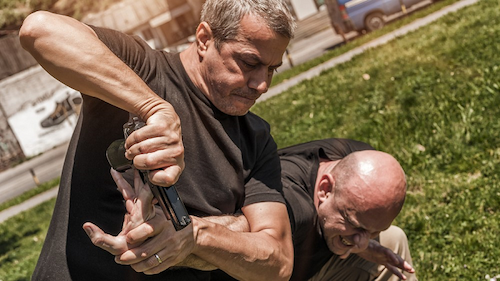What I learned from SEAL training was “Violence of Action” means the unrestricted use of speed, strength, surprise and aggression to achieve total dominance against your enemy. The way they win battles is they just overwhelm the enemy so they don’t want to be there anymore. If you don’t adopt this concept in your fighting mentality and truly and totally commit to violence of action you may not end up on top at the end of the encounter.
Don’t be afraid to hit first, and when you do, hit hard. If your verbal judo tells you this is your best and only option. Pull the trigger because you are in a battle! Your instincts, assessment and situational awareness have told you that you are in danger. You don’t know the other person’s intentions fully, and you never can. What you can do is survive – it is your right to not be killed or harmed by another person. As with most anything survival-related, fighting has its own set of priorities that need to be addressed at lightning speed. Here are the main steps.
1. Protect your face. Keep your hands up. A shot to the forearm is a lot better than one to the side of the head. There is a reason why this is first in survival because you can’t think if you are dazed by a barrage of punches.
2. Stay on your feet and keep moving. Two layers of protection are blocking/deflecting and moving. Both need to break down for you to get hit. Don’t put your feet close together. Maintain a good base in which to move in different directions.
3. Make your shots count. Hit hard but hit accurately. Power without accuracy is going to sap your energy. You won’t know how long this fight is going to last, so you better save a little in the tank.
4. Escape. My very first Master Chief told me that if I get in a bar fight, I better not get caught. The consequences will be undesirable. Don’t wait around. His friends might be just around the corner and what was once 1 vs 1 may now be 1 vs 3 or more.
Hit Accurately
Again, back to violence of action: Make every blow count and you could walk away; otherwise, you may be carried away. Punch, kick, elbow, gouge, bite, stab, rip, crush — you name it, you should do it, because this person is trying to take your life. The only rule in fighting is to live.
Vulnerable points exist all over the body, but remember that the greatest number of them exist from the collarbones up. Within this relatively small area of the neck you have:
• Two carotid arteries that feed blood to the brain.
• The windpipe, which is the airway for breathing.
• The spinal cord, which controls all motor skills for the body.
Your attacker may be three times your size, but if you take away even one of these functions, the fight is over. Even a 250-pound man made of solid muscle will stop fighting if he can’t breathe, which is why you must concentrate the full force of your attack on the face and neck area.
Punches
Make a fist and deliver a punch so you are ideally striking with the knuckles of the index and middle finger and punching through your target, as if you were trying to reach a place a few inches behind where you’re aiming. Then immediately return the hand to the defensive position by your face. You will increase the power of a punch by twisting your midsection in conjunction with the blow.
Jab: This is a punch thrown straight out, using your fist on your lead-leg side; it’s not the most powerful but is great for maintaining distance.
Cross: A punch straight in from opposite the lead leg — very powerful.
Hook: An outward arcing punch delivered by either fist — great for targeting the ear or jaw.
Uppercut: An upward arcing punch delivered by either fist — great for targeting the chin, and the best for lights-out!
Palm Strike
In addition to the above punches, your hands can also be very effective when clawing or jabbing with fingers, and an open palm strike can be devastating. The palm of the hand contains one of the densest bones in the body.
1. Open your palm and cock your arm back, just as you would for a jab punch.
2. Strike directly at the front of the nose and aim upward. A nose broken this way is much more painful than one that’s been hit from the side, and it will take the fight out of nearly anyone.
Chokeholds
The rear chokehold method (a.k.a. the lion killer) is a compression grip applied to the throat to disrupt circulation (carotid arteries) and breathing (windpipe), which ultimately causes the person to lose consciousness.
1. It is best applied from behind the attacker by wrapping your left arm around the person’s throat, with his windpipe in the crook of your arm, and your bicep and forearm on each side of his neck. The positioning of your arm is the key to this technique, so remember, the deeper you can get his throat between your bicep and forearm, the better.
2. Keep your right arm behind his neck and grab your left shoulder.
3. Then with your left arm, reach to grab your right arm’s bicep, squeezing tightly, making a full lock, or chokehold.
An alternate method is called the front chokehold, which works when you are facing your attacker.
1. With your right hand, reach across and literally grab the opposite corner of his shirt collar, not the person. You will have greater control over your adversary this way.
2. With your left hand, reach and grip the attacker’s collar on the opposite side. This will make your crossed arms an X in front of his throat.
3. Grip as tight as you can while rotating your hands forcefully inward to achieve the chokehold. You are twisting the opposite shirt collars as if you were squeezing and wringing out a rag.
Fighting an Assailant who has a Gun or Knife

If your assailant has a weapon, then your choices in defense will change. Disarming a person with a gun is incredibly risky. It takes a second to pull the trigger, so the best option might be to comply and wait for an opportunity to attack. However, if you are close enough and the situation necessitates you attack, your goal would be to use maximum effort and attack the weapon with the full intention to deflect his aim. Trying to wrestle the weapon from his grip is less likely to work than pushing his hand away, be it up, to the side or downward.
At this point, you may get the opportunity to strike at vulnerable areas and disable the attacker enough to get off the “X.” If the person has a knife, again, keeping your distance is the goal. Use your shirt, coat or whatever you can find to deflect his thrusting arm, which then could provide an opportunity to use defensive tactics.
Escape
Although this is the last step, avoiding fights altogether needs to be your first priority. Get off the “X” and save your fighting techniques for the gym. But you might need to strike first and hard to have the chance to get away. Don’t stay engaged if you can escape. The moment you have an opening, take it and leave the scene, because fights can change instantly and drastically.
We hope these tips will be helpful if you, unfortunately, find yourself being attacked. To be more confident with these moves and more aware of the best ways to defend yourself, consider signing up for some of our classes. Give us a call at 757-558-9869 or contact us to learn more.



